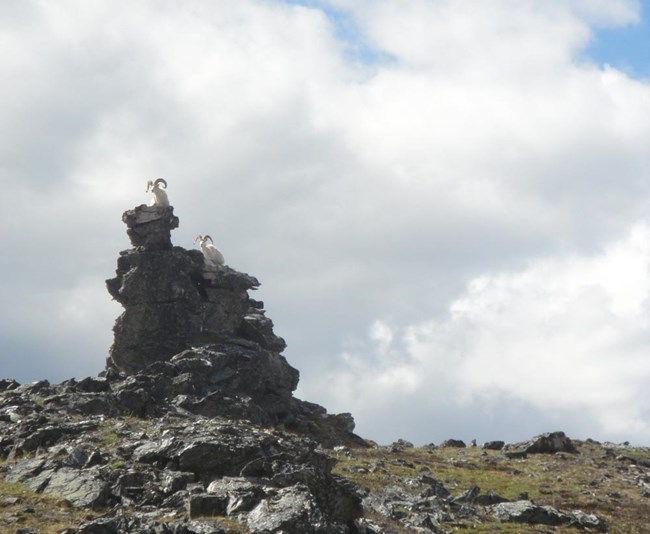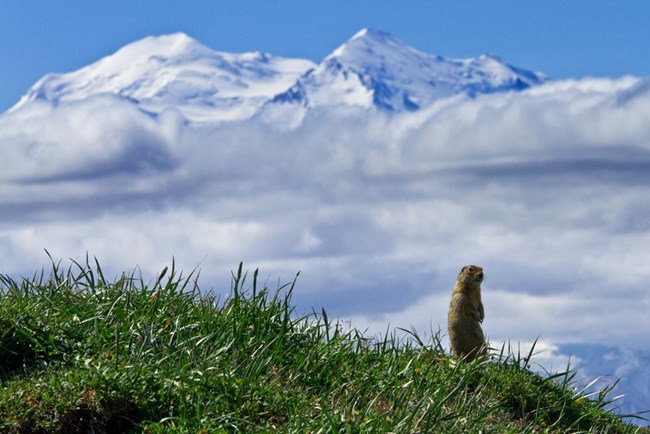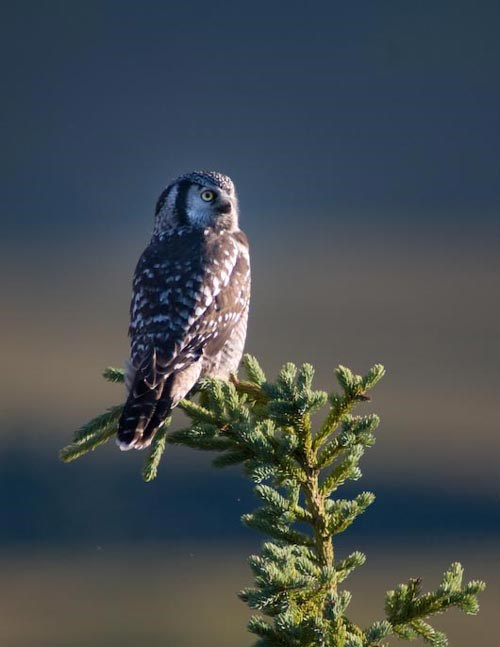More Than a MountainCongress created this park in 1917 specifically to protect the wildlife living along the slopes and in the valleys of the Alaska Range. Only as an addition in 1980, when Congress tripled the park in size, did the entire massif of "the Mountain" get squeezed into the boundaries of Denali National Park and Preserve. When you visit, you will follow in the eager footsteps of over 90 years of fellow travelers, many of whom sought glimpses of the far north's inspiring wildlife, roaming an undeveloped wilderness. Wild animals in Denali are not caged or trained - sightings of wildlife can never be guaranteed like in a zoo. However, the more time you devote to exploring Denali, the ever-greater your chances of seeing wildlife will be. 
NPS Photo / Chris Smith What Animals Live in Denali?In simple numbers, many animals live in this beautiful and remote place:
Some of the most iconic, large mammals, such as grizzly and black bears, wolves, caribou, moose and Dall's sheep, can be seen by lucky visitors. Some of the more-often seen small mammals include arctic ground squirrels, red squirrels, foxes and marmots. The bird life of Denali is varied and impressive. Golden eagles and the rare, often transitory bald eagles, are among the largest avifauna in the park. The most commonly seen birds include ravens, mew gulls, gray jays and ptarmigan. With no reptiles and only one type of amphibian, you are unlikely to see many cold-blooded animals in the park. Fish, too, are rarely found, as the rivers and creeks within easy reach of the Park Road are poor habitat—most fish in Denali live in the far western portions, where rivers deepen and sediment carried off the mountainsides has had a chance to settle, rather than clouding the water. Learn more about animals in Denali return to top of page Where Can I See Wildlife?Generally speaking, your best chances to see wildlife will be while riding a bus ride on the Denali Park Road. A bus offers numerous advantages for the wildlife seeker. You sit much higher than in a normal vehicle, enabling you to see over roadside brush. The bus will have dozens more eyes on it, allowing folks to look in all directions. A trained and experienced driver will take care of navigating you along the windy, serpentine Park Road, which at points travels along the sides of mountains, letting you relax and focus on the scenery and trying to spot animals. At numerous points the road rises above treeline, offering unimpeded views for miles around. Such areas are most likely to yield views of animals, although sometimes at a distance—bringing binoculars will help you enjoy viewing wildlife even at a distance. Any trip in Denali looking for wildlife has an element of chance to it—some trips are lucky and see a wide variety of wildlife, while others are less lucky and may only see a handful of animals.
By SpeciesWith the caveat that wild animals are unpredictable, and so no sighting can be guaranteed, here are a few potential areas to pay extra attention:
With the same caveat as above (i.e., wildlife sightings are unpredictable), below are some generalizations about the terrain, and what wildlife favors those areas, along the park road:
Off the Bus
You may encounter wildlife while hiking, although sightings are less common than while riding a bus. Visibility is often much reduced when hiking in or near brush, while animals accustomed to the nonthreatening noise of buses traveling the road may be easily spooked by your presence. If you plan to hike in Denali, you should learn the appropriate, safe behaviors in the event that you encounter a wild animal. Staying along rivers usually means greater visibility, but greater chance of encountering a moose or bear. Hiking in high alpine zones tends to mean you have more visibility, so you can avoid any large animals you encounter before getting too close.

NPS Photo / Jacob W. Frank What Time of Day is Best to See Wildlife?Some big game parks in Africa and elsewhere tout the opportunity to view wildlife at night, when many animals are more active. However, life in the far north is one of extremes, and one of the most immediately noticeable summer extremes is the length of daylight in Denali. On the summer solstice, around June 21 every year, sunrise is about 3:40 am, and sunset is 12:30 am - for roughly 21 hours, the sun is above the horizon. Even when the sun sets, twilight fills the entire period before it rises again.
So much daylight can cause some humans to sleep poorly, but it is a boon to wildlife. Extensive daylight allows vegetation to flourish, sustaining herbivores and, by extension, carnivores. Whether the animal in question is a seasonal migrant or a year-round denizen, wildlife must be active and make the most of the short, intense summer. Some animals are less active in midday, particularly if skies are clear and temperatures are warm. However, since bus trips in Denali take anywhere from 4 to 13 hours, almost every bus travels partly during the warm midday hours, and partly during the cooler morning or evening hours. Therefore, the best time of day to try seeing wildlife is any time you are on a bus. In winter, many animals migrate away to warmer climates, other parts of Alaska, or go into hibernation or torpor. Wildlife viewing in winter is much less common than in summer, though caribou, moose and wolves still roam the landscale, as well as smaller animals like foxes, coyotes and resident birds.
Learn more about the seasons of Denali return to top of page 
NPS Photo / Kent Miller Photography TipsOn any bus ride, your party will want at least one camera and one pair of binoculars to share. Occasionally, bus riders are lucky enough for animals to appear near, or even on, the Denali Park Road. Such opportunities offer fantastic views to the naked eye, and during these opportunities, even a smart phone can capture great photos. More often, however, you will see wildlife at a distance, particularly in areas where the road travels above treeline. In such cases, binoculars will be useful to truly observe animals, and a stronger camera may be necessary to take worthwhile photos. Buses have overhead racks for additional gear, should you own and wish to bring an extensive array of professional photography equipment. Whenever wildlife is sighted, your driver will position your bus for the best possible view. If the sighting is close to the road, you can expect to stop for quite some time; if the sighting is of wildlife a mile away or high up on a mountainside, the stop will probably be shorter.
Denali National Park and Preserve is about the same size as Switzerland, but it takes a far larger amount of land to support animals than in temperate regions. Even animals that travel in herds, like caribou and sheep, are usually only seen in small numbers, and sometimes at great distance. |
Last updated: August 7, 2020
